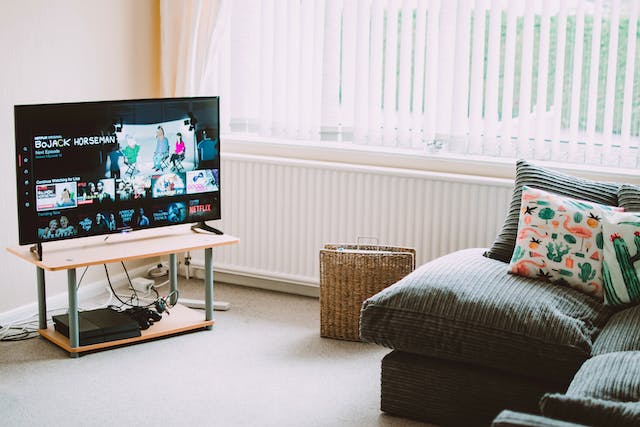
How does a TV screen display different colors? By using different intensities of red, green, and blue. These colors can be displayed with liquid crystal or with gases.
All screens, no matter how they are made, are divided up into pixels. The word pixel was made from a combination of “picture” and “element”. One pixel is made up of a black frame and three tiny dots of phosphors. Phosphors are chemicals that take in energy and emit light. When a phosphor is exposed to an electric current the electrons in the electric current sometimes collide with electrons around the phosphor atoms. The electrons are excited by this impact and the energy makes them jump to a higher orbital plane. Electrons cannot stay at an orbital plane that is not their own for long and they quickly return to their natural state. As they drop back down to their natural orbit, they release the energy as a light photon. Different phosphors release a different wavelength of energy. The three different types of phosphors that are used in a pixel emit photons in the wavelengths that we see as red, green, and blue.
When there is no electric current to the TV screen, we can only see the black frame that holds the phosphor dots, and the screen appears completely black. If all of the green phosphor dots are fed with a current, then the screen will appear green. Likewise, if the red and the blue phosphor dots are given a charge the screen would appear red or blue. If all three dots are given a charge and they all produce photons, we see the screen as white because white is composed of all of the colors.
The pixels are limited to red, green, and blue because those are the primary colors. Every other color is made up of a combination of those, and that is how the TV screen makes millions of other colors. By varying the strength of the electric current, each phosphor produces a different intensity of light. Each phosphor can produce 256 different intensities of light. So, for example, with different electric currents, the red pixel can produce 256 different intensities of red. That means, one pixel on a TV screen can produce 256 times 256 times 256, which is 16,777,216 different colors.
If you put your face close to the device you are reading this on, unless you are far sighted like me, you will probably be able to see the pixels. You will be able to see the gap between each pixel. Recently, screens are getting clearer, and we have high definition, 4K and now 16K TVs. This refers to the density of pixels in the screen. The more pixels in the screen, the closer they are together and the harder it is to see each pixel. This makes the image much higher quality.
The difference in TV screens is how they supply the energy to the pixels. There are cathode ray tube screens, plasma screens, and LCD screens (Liquid Crystal Display). Cathode ray tube TVs were the original form of TV we all owned in the 1980s and they were very big. These days, companies don’t produce cathode ray tube TVs anymore because the other technologies are better. A cathode ray tube is a way of producing and accelerating electrons. The electrons are controlled by a magnetic field and aimed at the pixels on the back of the screen. When a pixel is hit by the electrons, it produces a color. Cathode ray tube TVs do produce a good picture, but to make the screen bigger you have to make the cathode ray tube longer, which means the TVs are very big and heavy.
Plasma TVs were another method of getting energy to the pixels. They replaced cathode ray tube TVs because they could be much thinner, but the technology was phased out by about 2010 because they were very expensive, needed a lot of power, and, despite being thinner than cathode ray TVs, they were very heavy. The pixels are fixed at the back of a screen and behind each pixel is a tiny cell filled with a gas. When a current is applied to the cell, the atoms in the gas get excited and release ultraviolet light. The ultraviolet light hits the phosphor in the pixel, exciting it and producing visible light. The screens could be very big, but if a static image was displayed for too long it tended to burn into the screen. This is a reason why computers used to have screensavers.
Modern TVs all use LCD screens. The pixels are in the back of the screen, in the same way to the other types of screens. Behind the pixels is a layer of liquid crystal that is set into layers of glass that have microscopic grooves etched into them in different directions. The grooves cause the atoms in the liquid crystal to all align in the same direction. When an electric charge is applied to the liquid crystal in a specific location, it causes the atoms in the crystal to rotate. The liquid crystal cannot produce light, so all LCD screens have an LED at the back of them that is always on. When no charge is applied to the liquid crystal, the atoms are aligned in a direction that blocks out the light from the LED. When a charge is applied, the atoms rotate and let the light through, supplying energy to the phosphors in the pixels and producing an image. And this is what I learned today.
Photo by Lisa Fotios: https://www.pexels.com/photo/turned-on-flat-screen-smart-television-ahead-1444416/
Sources
https://www.chem.purdue.edu/gchelp/cchem/RGBColors/body_rgbcolors.html
https://stackoverflow.com/questions/48554884/how-many-colors-can-a-single-pixel-can-have
https://www.shsu.edu/~csc_dsb/DigitalImage/DigitalImages.html
https://www2.physics.ox.ac.uk/accelerate/resources/demonstrations/cathode-ray-tube
